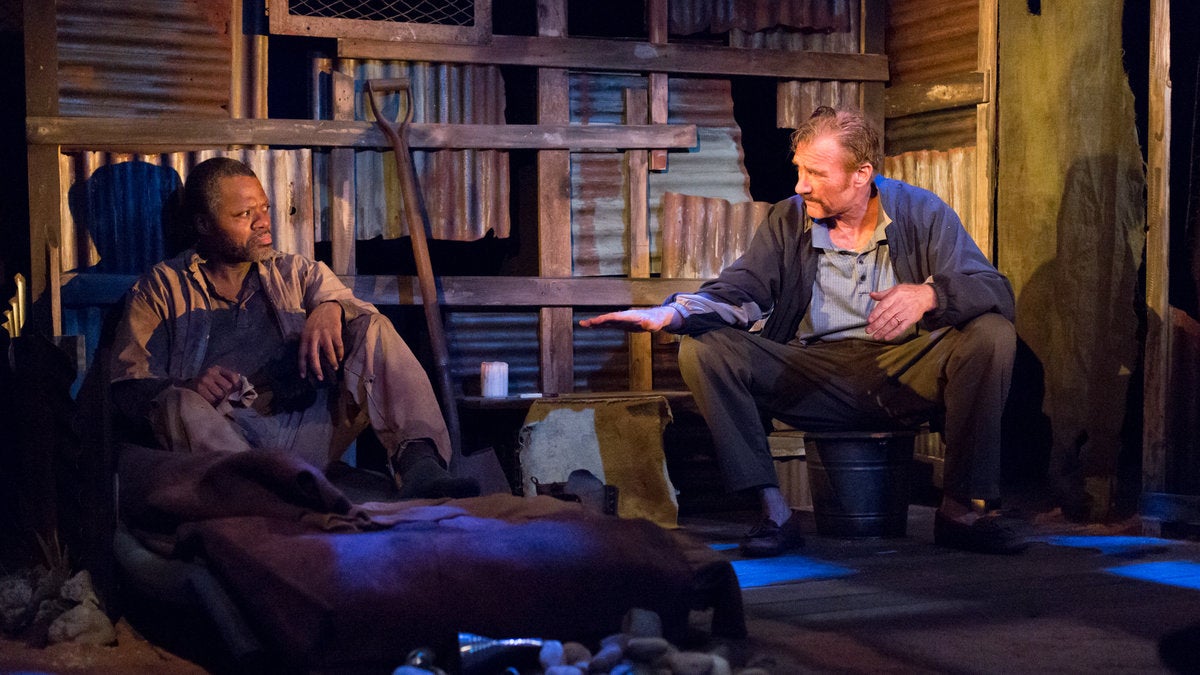Review: ‘The Train Driver’ and his derailment

Kirk Wendell Brown (left) and Peter DeLaurier in Lantern Theater Company's production of 'The Train Driver' (Photo courtesy of Mark Garvin)
It’s an all-too-common story around the world: a train comes down the tracks, a despondent person runs in its way.
It’s sometimes the horrible meaning behind the phrase “police activity on the tracks” that you hear on radio traffic reports. In a production by Lantern Theater Company, it’s also the theme of South African playwright Athol Fugard’s “The Train Driver,” his two-person play set in a graveyard where unidentified people are buried.
There, in what was once a black township and is now a rough and scary neighborhood, a white man has come to find one, and maybe two, bodies. He is fallen and frantic, and looks every bit the part – the locally-based Peter DeLauier, a single large curl dangling over his forehead, is remarkable in the role. The white man tells the gravedigger who lives at the ramshackle graveyard that he’s come to curse the woman’s corpse when he find it.
Or if he finds it. None of these graves has real markers with names – only a tin can here, a few stones there, an occasional dish or hubcap. These bodies are the unclaimed leftovers of the earth’s souls, “the ones with no names” as the gravedigger puts it.
Still, the man insists. He is angry and confused, a train engineer who looked below into the eyes of a woman in the final second of her life. She was with a baby. Her tragedy becomes his.
As night falls and the place becomes ever more dangerous, the grave-digger allows the train driver to stay with him and resume his search the next day. The gravedigger – beautifully rendered by Kirk Wendell Brown, whose reactions are perfect during long periods of exposition by the white man – suggests that if a white person is found on the property, both their lives are at risk.
Fugard, whose masterful stage work exploring South Africa’s apartheid and a lifetime Tony Award honoree (he is 81), wrote “The Train Driver” in 2010. There’s also mastery in this play, in the way it illuminates two different South Africas as they exist after apartheid – a white one and a very poor black one, as different as two plants but tied to the same path in orbit.
Yet it’s not as strong as a piece of theater. The 90-minute one-act doesn’t have much literal room to move – although under Matt Pfeiffer’s thoughtful direction for Lantern Theater, it physically moves whenever possible – because the real action here is internal. It’s the melding of minds between the two characters as they begin to understand and even trust one another.
Fugard takes his time – too casually – setting up this circumstantial accord. We hear stories about this and that from the past. The dialogue, much of it in darkness after night falls, becomes a little forced and sleepy. We know these are awkward moments for both men, and a story about what my mother said or did seems out of the moment, or fails to move the moment along. Much of it also becomes the train driver’s monologue.
But leave it to Fugard. Once he’s finally established an affinity between the two men, the play shifts into another dramatic gear, an impressive one that underscores the sense of hopelessness that Fugard is a master at creating. In the meantime, though, he’s created an transformation between the two men that’s the most powerful element of “The Train Driver,” and that shines through the darkness in Lantern’s production.
“The Train Driver,” produced by Lantern Theater Company, runs through May 4 at St. Stephen’s Theater, 10th and Ludlow Streets (between Market and Chestnut). 215-829-0395 or www.lanterntheater.org.
WHYY is your source for fact-based, in-depth journalism and information. As a nonprofit organization, we rely on financial support from readers like you. Please give today.




